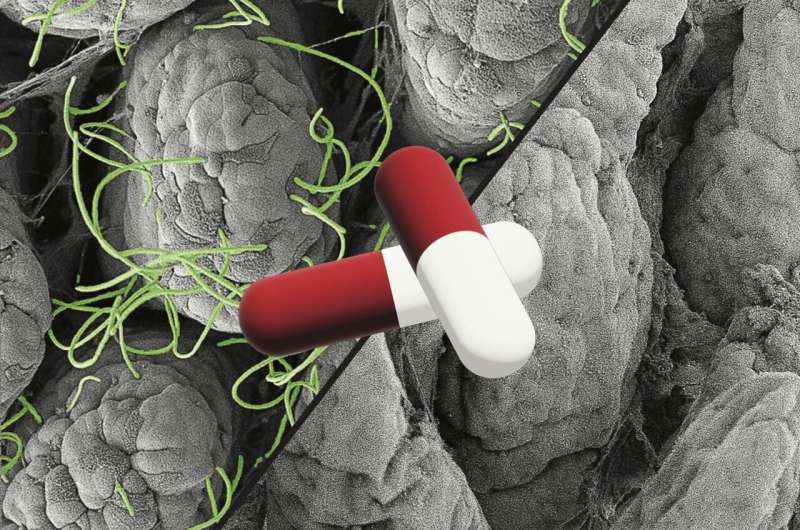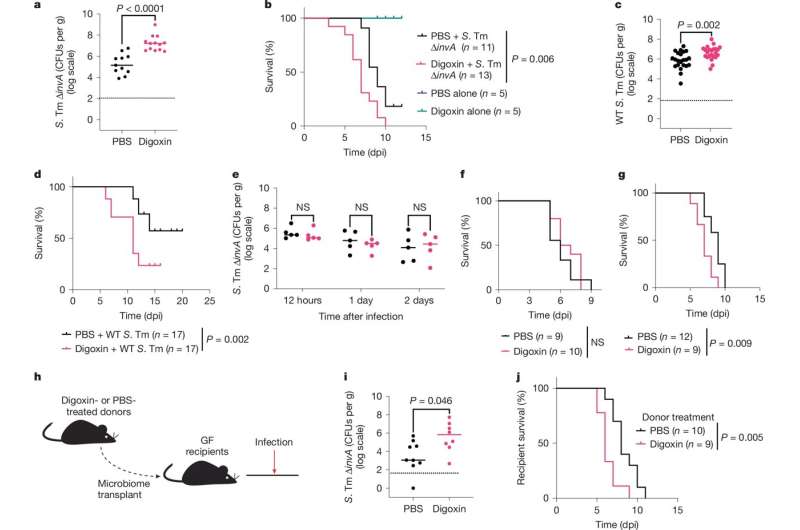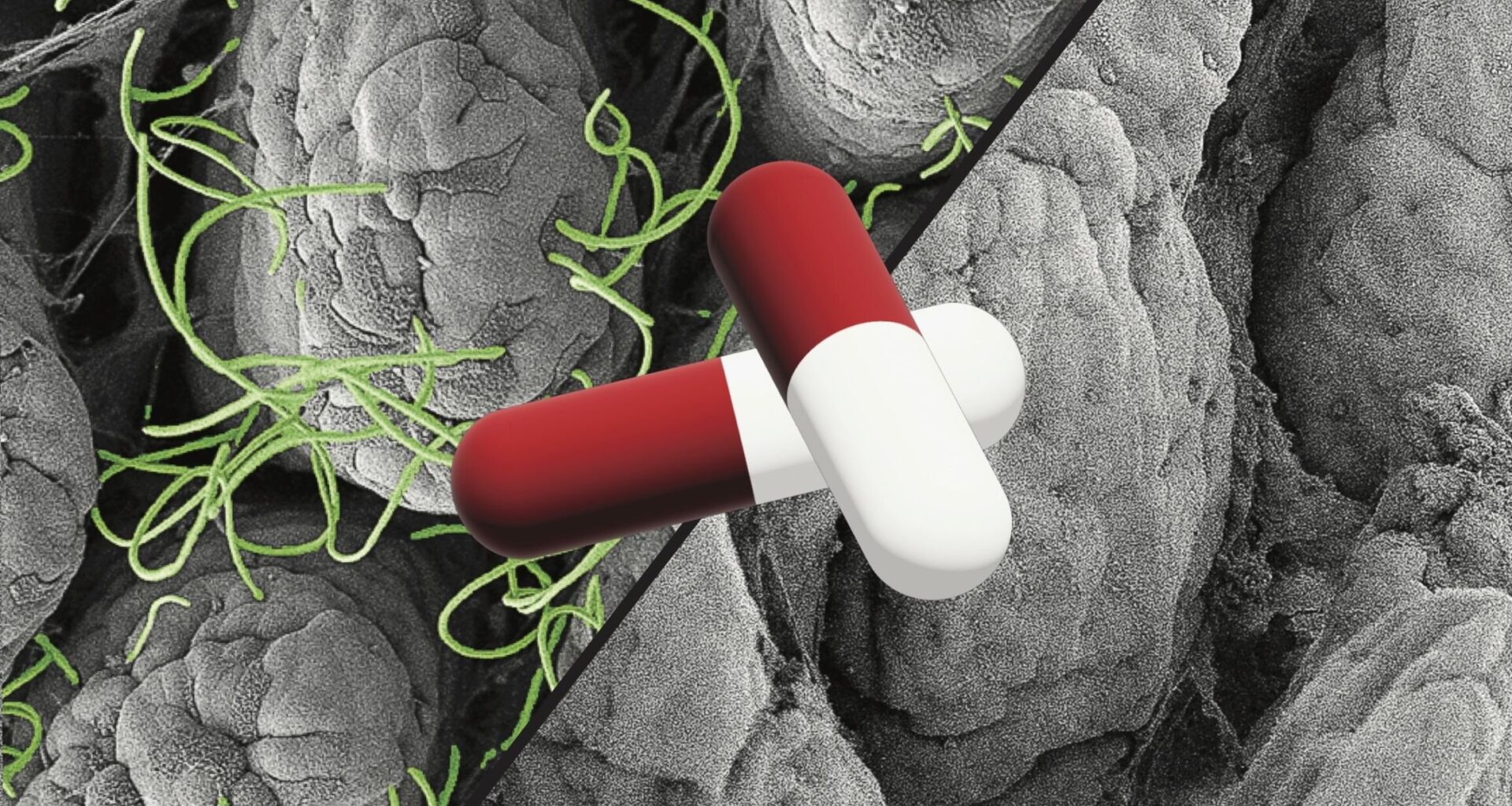
Credit: Jack Botting, Yale University
Non-antibiotic drugs can alter the microbiome and increase the risk of gut infections in surprising ways, a new Nature study shows.
Antibiotics taken to treat an infection also kill some of the good bacteria that live in our body. When that happens, the microbiome—all of the microorganisms, including bacteria and fungi, that live in our body—loses colonization resistance, or the ability of good microbes to prevent harmful ones from taking over.
Growing evidence shows that non-antibiotic drugs can disrupt the microbiome as well. However, it has been unclear which of these disruptions might be readily tolerated and which disruptions increase the risk of health complications.
In the new study, Yale School of Medicine (YSM) researchers identified several common prescription, non-antibiotic drugs that altered the gut microbiome, and discovered that at least one of these drugs triggers mice to produce anti-microbial agents that target their own gut microbes.
The findings suggest the microbiome could influence why some people respond well to drugs, while others don’t. And it could be a target for improving drug responses in individuals.
Using GI infection as a clue
When Aman Kumar, Ph.D., and Andrew Goodman, Ph.D. set out to explore how non-antibiotic drugs impact the microbiome, they faced a problem: Many existing studies that followed participants and their microbiomes over time were too small to capture disruptions caused by drugs, while larger studies following more participants over decades seldom looked at the microbiome at all.
However, the researchers believed that large-scale studies may still contain clues, even if they didn’t measure microbiomes directly. Individuals with disrupted microbiomes are at increased risk of gastrointestinal (GI) infection because decreased colonization resistance makes it more difficult for gut microbes to fight off pathogens.
They hypothesized that identifying prescription drugs associated with an increased risk of GI infection could help them pinpoint which were disrupting the microbiome.
Through collaboration with epidemiologists, the researchers analyzed over a decade’s worth of medical records and pharmacy claims data from 1 million anonymous individuals enrolled in universal health insurance in Montreal, Canada to determine the incidence of GI infections.
“We found prescription drugs that increased people’s risk of infections to the same degree that antibiotics would,” says Goodman, C.N.H. Long Professor of Microbial Pathogenesis, chair of microbial pathogenesis at YSM, director of the Microbial Sciences Institute at Yale West Campus, and the study’s principal investigator.
Based on their findings, the researchers selected 21 drugs for further study.
Digoxin alters the microbiome in a surprising way
To explore how these prescription drugs impacted the microbiome, the researchers treated mice with each drug and analyzed fecal samples collected from the mice before the first dose and after the final dose.
The researchers found about half of the drugs were associated with changes in microbiome composition. And four—congestive heart failure medication digoxin, anti-seizure and anti-anxiety drug clonazepam, stomach acid-reducer pantoprazole, and anti-psychotic medication quetiapine—were associated with an increased risk of infection following pathogen exposure.

The effect of digoxin on infection risk is transmissible through the microbiome. Credit: Nature (2025). DOI: 10.1038/s41586-025-09273-8
Because digoxin was associated with the most significant microbiome changes, the team chose to study this drug even further. They found that rather than directly targeting gut microbes, digoxin instead triggered a biological pathway that caused mice to release antimicrobial proteins into the small intestine.
Interestingly, these antimicrobial proteins only targeted specific microbes.
“Among the hundreds and hundreds of microbial species in the gut, there’s a very small number that are actually affected,” says Goodman. “But even though the number of species is small, the impact of losing them is enormous.”
Before the administration of digoxin, he explains, there are various species of gut microbes that keep the immune system on alert in case a pathogen arrives. When digoxin-induced antimicrobial proteins eliminate those species, the host loses this “alert status” and is no longer prepared to fight off infections.
“And because of that, the gut becomes suitable for a pathogen like Salmonella to grow in that niche and expand, causing infection,” says Kumar, a postdoctoral associate at YSM and the study’s first author.
Mouse and human gut microbes look different. So, the researchers also repeated their experiments in mice carrying human microbiomes and found similar results.
Further exploring the microbiome
Millions of people in the United States take prescription drugs. While the study’s findings don’t mean that patients need to toss their medications, researchers have more work to do to understand the consequences of these drugs more fully on the microbiome.
Kumar says he hopes to use similar methodology to explore how drugs might be impacting other microbiome-related diseases such as inflammatory bowel disease and colon cancer.
“Our study provides a new, innovative framework to study drug-induced microbiome disruption,” Kumar says. “The gut microbiome and GI diseases are closely linked, and if these connections were understood, it would open new doors for identifying who is at risk and possible therapeutic interventions.”
In addition, even while taking the exact same medication, people’s experiences can drastically differ. One person might benefit from one drug, while another with the same disease has no relief. A certain drug might trigger a range of side effects in one person, but none in someone else.
“Our overall hypothesis is that in some of these cases, differences in people’s gut microbiomes could contribute to these different responses to drugs,” says Goodman. In future research, the researchers will explore if they can use people’s microbiomes to predict who is at the greatest risk of infection while taking drugs like digoxin.
“I think there’s a possibility for interventions in the future where you could alter a person’s microbiome so that they would no longer have these risks associated with a drug that would benefit their health,” Goodman adds.
Finally, the study has highlighted the value of existing epidemiological cohorts, even when they do not contain data directly on the microbiome.
“There are all of these cohorts that have looked at populations all over the world of different ages and lifestyles,” says Goodman. “The opportunity to revisit those with an eye for indicators of microbiome disruption opens up a whole new field for us.”
More information:
Aman Kumar et al, Identification of medication–microbiome interactions that affect gut infection, Nature (2025). DOI: 10.1038/s41586-025-09273-8
Provided by
Yale University
Citation:
Non-antibiotic drugs can also disrupt the microbiome (2025, August 6)
retrieved 7 August 2025
from https://medicalxpress.com/news/2025-08-antibiotic-drugs-disrupt-microbiome.html
This document is subject to copyright. Apart from any fair dealing for the purpose of private study or research, no
part may be reproduced without the written permission. The content is provided for information purposes only.
